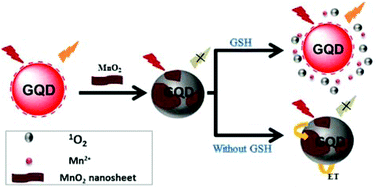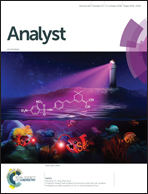A graphene quantum dot-based multifunctional two-photon nanoprobe for the detection and imaging of intracellular glutathione and enhanced photodynamic therapy†
Abstract
A multifunctional nanosystem, which integrates biosensing, bioimaging, and therapeutic functions into a single nanoprobe, is of great significance for biosensing and biomedicine. Near-infrared (NIR) graphene quantum dots (GQDs) have emerged as an attractive bioimaging and therapy tool for exploring biological events because they can provide deep imaging penetration and low fluorescence background and produce 1O2 for PDT. Here, we reported a GQD-based multifunctional two-photon nanoprobe for intracellular tumor-related glutathione (GSH) detection and enhanced photodynamic therapy by reducing GSH levels in cancer cells. By taking the excellent quenching property of MnO2 nanosheets and the reduction ability of GSH, a GQD@MnO2 nanoprobe was developed through adsorption of MnO2 nanosheets onto the surface of GQDs for sensing intracellular tumor-related GSH. The nanoprobe shows a highly sensitive response to GSH in aqueous solutions with a detection limit of 83 nM. It also exhibits a high selectivity toward GSH relative to other biomolecules and electrolytes. In addition, once endocytosed, the MnO2 nanosheets are reduced by intracellular GSH, simultaneously releasing GQDs and decreasing the level of GSH for highly efficient PDT.



 Please wait while we load your content...
Please wait while we load your content...